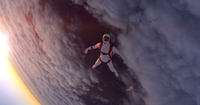
Cutting Edge’s TVC for the Sony A7 camera takes four cosmonauts high into the stratosphere to watch the earth, weightless, from a new perspective.
Sky Divers |
|
Cutting Edge produced Sony China’s recent TVC for the A7 camera with agency M&C Saatchi, who asked the team to convey the idea of floating, weightless, high in earth’s stratosphere and watching the earth from a new perspective. The 60 and 30 second spots were directed by Jeff Gaunt at Cutting Edge, and show cosmonauts floating in near space, capturing shots on new A7R cameras, with the earth’s surface curving away into the distance below them as a backdrop. Jeff explained the demands, limitations and challenges of the shoot and post production, which were met through careful planning, experimentation, experience and teamwork. Visual AuthenticitySony wanted a film that communicated to viewers the characteristics that made their new camera a ‘world-first’. “The concept demanded visual authenticity, and shooting from the sensational height of 15,000 feet was necessary to express the narrative,” said Jeff. To get the results he needed, Jeff engaged a base jumper, parachuting and skydiving DP Shane Sparks, and his camera assistant Rob Douthat. |
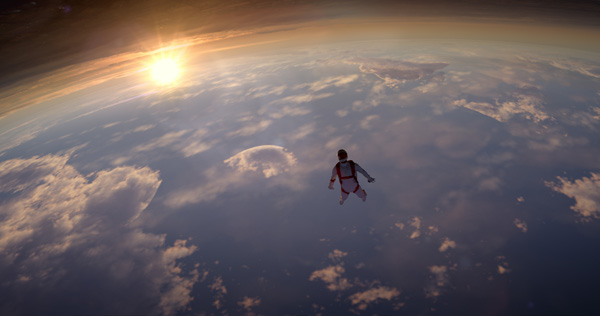 |
|
The video was shot by two skydiving cinematographers who were both wearing a head mounted Sony A7R and shooting with a cinema camera capable of recording 4K. Due to the nature of the shoot, of course, no monitors could be used. Instead, the DP wore a glass eyepiece mounted over one eye to compose the shots. The Sony A7R was recording stills to the internal SD card while the video was recording to a high-res cinema capture card. “The film took place from Nagambie sky dive centre which operates a custom built PAC XL 750 aircraft,” Jeff said. “The plane has a caravan-sized door and is able to quickly handle fast turnarounds for the multiple jumps we had to make. All of the jumps were made from 15,000 feet, the maximum height the four divers could go. The head mounted cameras were bolted to the DP's helmet and no special stabilizing rigs were used or needed.” |
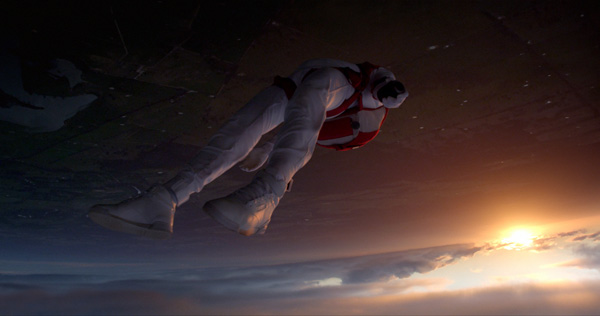 |
Nine JumpsNine jumps were allocated to cover the whole spot, each with a freefall time of about one minute, in which they aimed to achieve two or three different shots. Furthermore, in order to work with the correct lighting, Jeff was only able to shoot during two brief sessions per day. Because each jump, from preparation to reaching the necessary altitude to landing, took just under an hour, the result was only four jumps a day, two in the morning and two in the afternoon, to get it right. In turn, the two-day shoot gave them just nine minutes in which to shoot the commercial. “Choreographing the four divers and the camera started with a 3D previz,” he said. This process was initially used as a point of discussion between the director and the DP to determine what could and couldn't be achieved during each sky dive. It was also used to replace storyboards and was presented to the agency and client along with the director’s treatment. The previz was also used on set to help us break down the choreography and camera work for each jump. The skydivers and DP would then go through a process called a dirt dive. This is a practical rehearsal played out on the ground, using the plane and all the actors and DP.” |
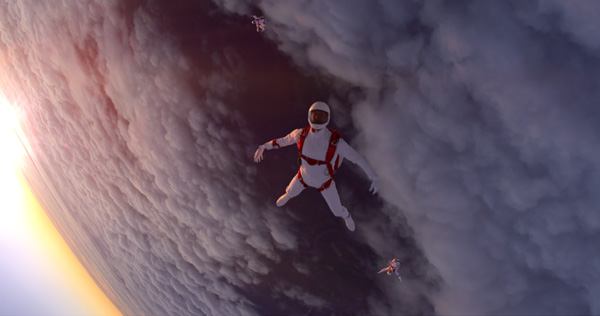 |
|
During pre-production, the team had been made aware of certain delivery requirements. They needed to deliver the commercial at 4K resolution, and any still images used had to actually be shot with the Sony A7R. This last requirement came from the Chinese advertising authority, who needed to see all RAW footage to ensure the authenticity of what viewers would see. This precluded any plans they had considered of capturing some of the action on blue screen. Slow Motion PlanningJeff said, “My early tests of slowing down footage to create the weightless feeling had shown that I needed to shoot the commercial at 1,000 to 2,000 fps. Currently, there is no camera that can shoot at those frame rates at 4K, and also be mounted on someone’s head. My solution was to shoot at 120 fps on a 4K cinema camera with a shutter speed of 1/500 and slow the action down in post production to the equivalent of 1,000 fps or higher depending on the shot. |
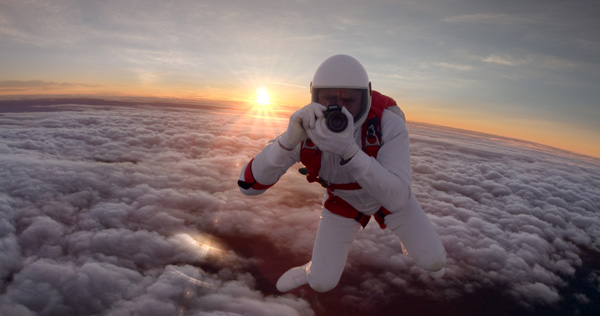 |
|
“Some of the shots, including the opening, were taken with the diver and DP inverted. Doing this, along with a using a fish eye lens, creates the feeling of space. Other shots were taken the right way up for one of two reasons – either the actors couldn't perform the required action upside down, or the cloudscape looked better below them than above. It really depended on what looked best at the time. Also, due to the Chinese regulations, we were unable to alter any shots featuring stills in the commercial and consequently we didn't know exactly what was going to be used in the final edit. This meant that every shot need to look great straight out of the camera, relying only on minimal post production to enhance shots.” Mastered at 4KMost of their post production tasks involved slowing down the shots and adding some additional curvature to the background in selected shots. The fish eye lens curves the horizon nicely when it is located in the lower third or upper third of the image, but if it fell anywhere in between, the effect needed some help. All of the rushes went through Cutting Edge's Baselight grading system with Nuke support to create mattes of the cosmonauts to help separate their white space suits from the white clouds. The online edit was completed in Flame and mastered at 4K and HD. |
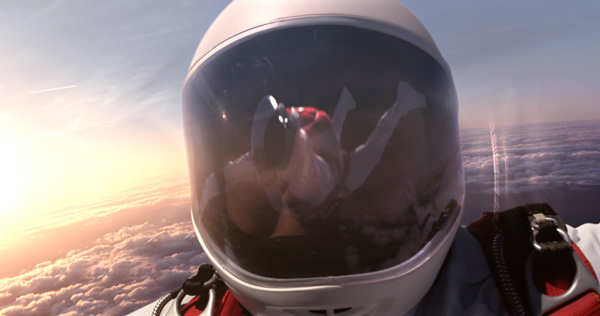 |
|
Jeff can proudly say that all of the shots were actually captured in the air, a testament to the team’s careful planning and also the bravery of the divers, some of whom hold world records for their daring stunt dives. Jeff said, “In the final edit, however, we did go for one pickup shot, a product shot that we organised on the ground, when we see the lens attaching to the camera body - but that was only because we wanted the beautiful sun flare you see as the lens and body come together!” The spot has been showing in China since late December 2013. Global distribution is now in the planning stages, and the addition of a 4K master means that it can be shown on Sony’s 4K Bravia televisions. You can view the Sony A7 spothere. www.cuttingedge.com.au |


















